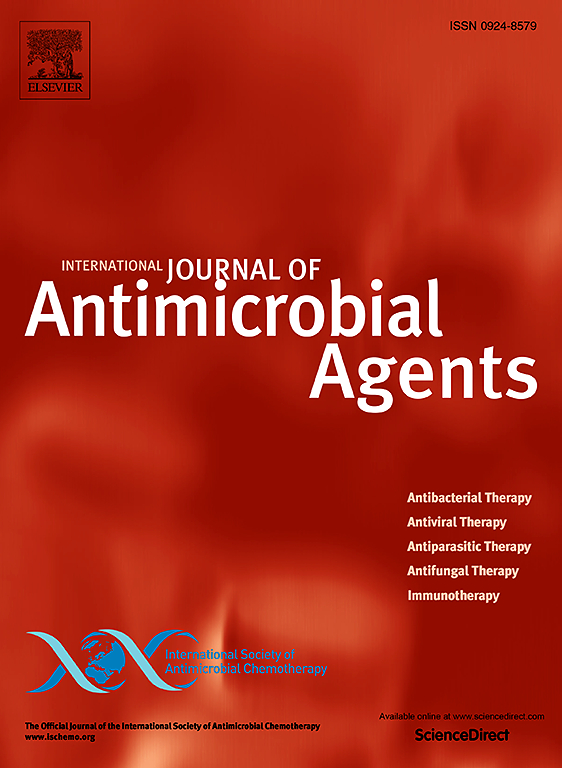临床MRSA中奥马达环素耐药性的分析:一项全国基因组调查和体外进化分析。
IF 4.9
2区 医学
Q1 INFECTIOUS DISEASES
International Journal of Antimicrobial Agents
Pub Date : 2025-04-01
DOI:10.1016/j.ijantimicag.2025.107499
引用次数: 0
摘要
目的:评价临床耐甲氧西林金黄色葡萄球菌(MRSA)对奥马达环素的敏感性,探讨其耐药机制。方法:采用肉汤稀释法测定所有MRSA分离株的奥马达环素mic。具有代表性的临床MRSA分离株ST59、ST5和ST9暴露于浓度增加的奥马达环素中。产生奥马达环素耐药的突变体被分离、测序并使用breseq进行比较。利用分子克隆技术研究了耐药机制。结果:奥马达环素对MRSA的mic范围为0.06 ~ 8 mg/L, MIC50和MIC90分别为0.25和4 mg/L,总耐药率为13%。所有CC59株对奥马达环素敏感。耐药菌株主要集中在HA-MRSA克隆CC5中。47株mic≥4 mg/L的分离株均携带tet(M)和rpsJ K57M突变。克隆实验表明,tet(M)和突变的rpsJ都降低了对奥马达环素的敏感性。rpsJ基因是不同MRSA谱系中降低奥马达环素敏感性的共同靶点。连续暴露于奥马达环素诱导ST9中rpsJ (H56Y)新突变ST59中的H56R, K57M;和ST5中的K57M、H56Y),克隆实验证实这些基因可以可变地降低奥马达环素的敏感性。此外,突变的mepA也有助于降低对奥马达环素的敏感性。结论:不同MRSA菌株对奥马达环素的敏感性存在差异,部分CC5菌株表现出耐药表型。rpsJ基因可作为omadacycle耐药进化的一般靶点,在未来四环素衍生物的改良中发挥重要作用。本文章由计算机程序翻译,如有差异,请以英文原文为准。

Profiling of omadacycline resistance in clinical MRSA: A nationwide genomic survey and in vitro evolutionary analysis
Objective
We aimed to evaluate the susceptibility of various clinical methicillin-resistant Staphylococcus aureus (MRSA) lineages to omadacycline and investigate the mechanisms underlying omadacycline resistance.
Methods
Omadacycline MICs for all MRSA isolates were determined via broth dilution. Representative clinical MRSA isolates of ST59, ST5 and ST9 were exposed to increasing concentrations of omadacycline. Mutants developing omadacycline resistance were isolated, sequenced, and compared using breseq. Molecular cloning was employed to elucidate the mechanisms of omadacycline resistance.
Results
Omadacycline MICs against MRSA ranged from 0.06 to 8 mg/L, with MIC50 and MIC90 values at 0.25 and 4 mg/L, respectively, and an overall resistance rate of 13%. All CC59 isolates were susceptible to omadacycline. Resistant isolates were mainly concentrated in HA-MRSA clones CC5. All 47 isolates with MICs ≥4 mg/L harbored tet(M) and the rpsJ K57M mutation. Cloning experiments demonstrated that both tet(M) and mutated rpsJ reduced susceptibility to omadacycline. The rpsJ gene was a common target in different MRSA lineages for decreased omadacycline susceptibility. Continuous exposure to omadacycline induced novel mutations in rpsJ (H56Y in ST9; H56R, K57M in ST59; and K57M, H56Y in ST5), which cloning experiments confirmed could variably reduce omadacycline susceptibility. Furthermore, mutated mepA also contributed to reduced omadacycline susceptibility.
Conclusion
Susceptibility to omadacycline varied among different MRSA lineages, while some CC5 isolates exhibiting the resistance phenotype. The rpsJ gene serves as a general target for the evolution of omadacycline resistance and plays an important role in the refinement of future tetracycline derivatives.
求助全文
通过发布文献求助,成功后即可免费获取论文全文。
去求助
来源期刊
CiteScore
21.60
自引率
0.90%
发文量
176
审稿时长
36 days
期刊介绍:
The International Journal of Antimicrobial Agents is a peer-reviewed publication offering comprehensive and current reference information on the physical, pharmacological, in vitro, and clinical properties of individual antimicrobial agents, covering antiviral, antiparasitic, antibacterial, and antifungal agents. The journal not only communicates new trends and developments through authoritative review articles but also addresses the critical issue of antimicrobial resistance, both in hospital and community settings. Published content includes solicited reviews by leading experts and high-quality original research papers in the specified fields.

 求助内容:
求助内容: 应助结果提醒方式:
应助结果提醒方式:


